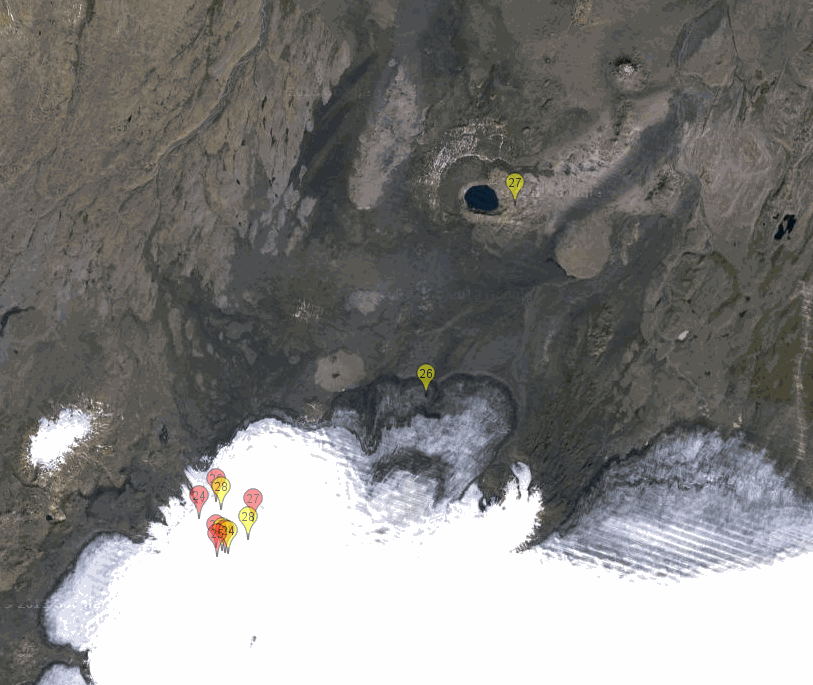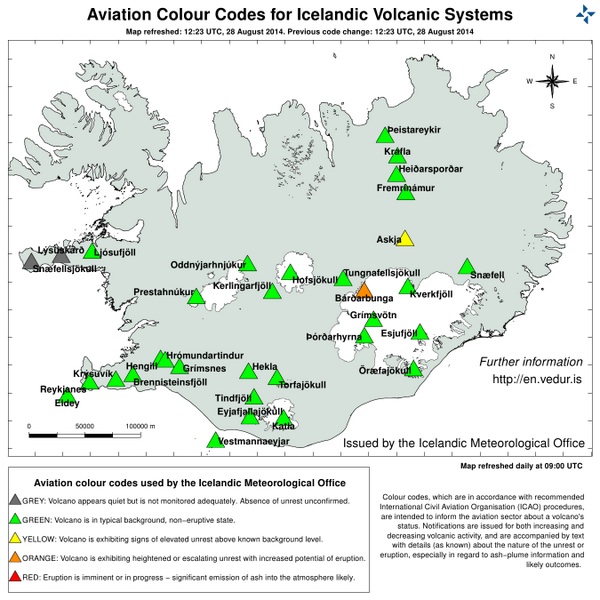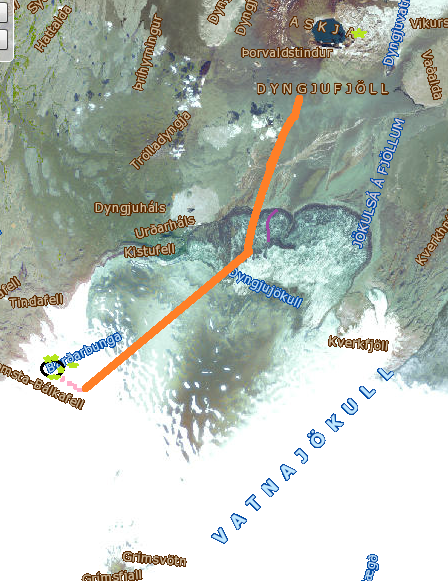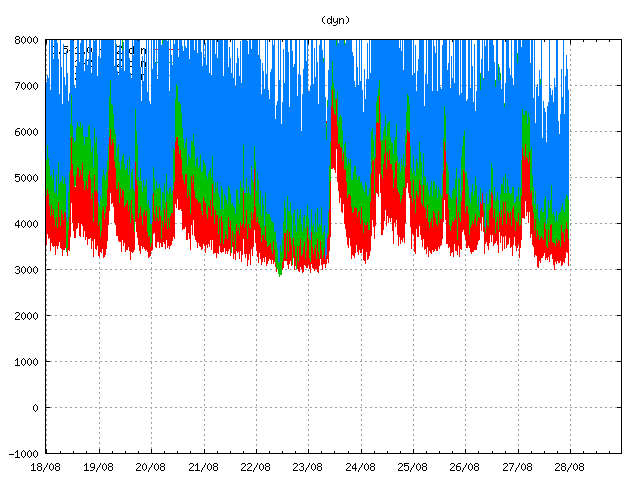It looks like you're using an Ad Blocker.
Please white-list or disable AboveTopSecret.com in your ad-blocking tool.
Thank you.
Some features of ATS will be disabled while you continue to use an ad-blocker.
share:
Seismic Activity Drops, No Signs of Big Eruption by Bárðarbunga
icelandreview.com...
Compared to previous nights, last night was rather quiet as far as seismic activity goes in the area around Bárðarbunga. The largest earthquake was of 4.1 magnitude. Almost 400 quakes were picked up by sensors, most by the northern tip of the intrusive dyke. There were also some minor quakes near Askja volcano.
Four calderas, also known as lows or cauldrons, were seen in the glacier east-southeast of Bárðarbunga during an observation flight yesterday, indicating melt caused by great geothermal activity or possibly a sub-glacial eruption.
Geophysicist Magnús Tumi Guðmundsson told ruv.is this morning that a significant amount of ice has melted, yet earthquake monitors show no signs of a big eruption.
icelandreview.com...
another 5.0 just hit...
www.emsc-csem.org...
They moved the location, but now it's near where the dyke intrusion started...
confusing, all this...
www.emsc-csem.org...
They moved the location, but now it's near where the dyke intrusion started...
confusing, all this...

right click, "view image" for larger version
yellow is M4
red M5
number is the date August 2014
good night, and good luck up there
edit on 0800000023923914 by muzzy because: (no reason given)
#Bárðarbunga has orange aviation code and #Askja yellow. Interesting development.
From Twitter - here it is,

And the Askja caldera, (I believe)

edit on 28-8-2014 by Doodle19815 because: (no reason given)
It makes sens to put Askja on Yellow Alert with the dyke reaching the fissure system of Askja.
en.vedur.is...
en.vedur.is...
The dyke needs some theme song music as it gets closer to Askja.
(Olivine's Pic)

(Olivine's Pic)

edit on 28-8-2014 by Darkblade71 because: (no reason given)
The Askja crater lake is at least 220m deep and 4 - 5 km in diameter - that is quite a lot of water on top !!!!
Askja Google maps location
Askja Google maps location
a reply to: DAZ21
From your link -
From your link -
Askja volcano
The dyke from Bárðarbunga volcano has entered Askja volcano. Not the fissure swarm, the volcano it self. Askja volcano status has been elevated to Yellow.
Bárðarbunga volcano
Cauldrons in Vatnajökull glacier that is on top of Bárðarbunga volcano have not grown during the night. The water seems to be flowing into Grímsvötn (Grímsfjall volcano) lake. It has risen close to 15 meters in the past few days.
Earthquake activity is high.
Both in the main volcano were a magnitude 5,4 earthquake (EMSC magnitude, USGS magnitude) took place today (28-August-2014) at 08:13 UTC. The earthquake took place in the caldera rim as most of the large earthquakes have happened.
Over 1300 earthquakes happened yesterday in the north end of the dyke swarm. Cracks have started to happen in the crust above the dyke. This means the dyke is getting wider and is higher up in the crust then suggested by earthquake activity.
There are reports of small cauldrons in Dyngjujökull glacier in the area, in the place were the glacier is thinnest and ending.
Harmonic tremor remains high on all SIL stations around Bárðarbunga volcano. The situation is extremely dynamic and is going to change fast in next 24 to 48 hours.
I am not close to 80% sure that an eruption is going to take place in both Askja volcano and Bárðarbunga volcano, since minor eruptions have been taking place under the glacier already.
a reply to: TrueAmerican
Are you seeing the signs of Harmonic tremor? For some reason I had thought that it wasn't showing HT yet....
According to my link posted above, the HT is high. Correct me if I am wrong, (please), but I always thought HT meant eruption was underway.
Are you seeing the signs of Harmonic tremor? For some reason I had thought that it wasn't showing HT yet....
According to my link posted above, the HT is high. Correct me if I am wrong, (please), but I always thought HT meant eruption was underway.
There is change that both volcanoes are going to erupt. If Askja erupts, it doesn't mean that Bárðarbunga isn't going to erupt. There is enough
magma for both volcanoes. Askja isn't as dangerous as Bárðarbunga though, but there is lot of water above the Askja caldera, which could mean very
explosive eruption, type Laki eruption.
a reply to: BGTM90
As in one of these:
Flood Basalts and Mass Extinctions
If I am right this will most likely lead to an increased risk for a flood basalt event.
As in one of these:
A possible scenario is that a single flood basalt eruptive event - more than 1000 cubic km - would erupt a very large mass of sulfur dioxide gas and aerosol, some of which would enter the lower stratosphere. This would reduce the amount of light reaching the Earth's surface (e.g., Thordarson and Self, 1996; Self et al., 2006).
As a result, not only is the lower atmosphere cooled, but also photosynthesis could be reduced or even stopped if light transmission is sufficently impaired. A volcanic winter may ensue, lasting for the duration of the eruption (decades?) (Rampino et al., 1988).
Flood Basalts and Mass Extinctions
a reply to: TrueAmerican
Hi TrueAmerican. Nice to see you. Here is the thinking about the missing water.
From the most recent Icelandic Seismic advisory meeting
And if you haven't seen the 3-D time lapse of all the earthquakes from 16 August thru 10:30 utc today, check this out!
(Be patient, it takes a few seconds for the page to get started. Once it does, I recommend clicking the "10x" or at minimum the "2x" speed buttons in the top right of the screen, otherwise the animation takes 8-10 minutes to cycle. It works fine using Chrome, but some folks report problems in Firefox)
ETA: I had to fix my obligatory spelling mistakes, and wanted to comment on "harmonic" tremor.
In my opinion, we will not see harmonic-type tremor unless there is an eruption from the main conduit under Askja. Harmonics are thought to be caused by rapid-fire rock breaking in a narrow conduit, leading to explosive eruption. The dike intrusion is a wide (meter+) tensional spreading event, not likely to cause harmonics. Just MHO.
Hi TrueAmerican. Nice to see you. Here is the thinking about the missing water.
From the most recent Icelandic Seismic advisory meeting
The water level in Grímsvötn Lake has been surveyed and has likely risen by about 5-10 m in the last days, which corresponds to an addition of 10-30 million m³ of water in the lake. A slight increase in conductivity in Köldukvísl River was measured this morning, but the cause is yet unknown. No change has been measured in the Hágöngulón lagoon, Jökulsá River and Skjálfandi River. It is assumed, that the water from the cauldron has flowed into the Grímsvötn Lake or the river Jökulsá á Fjöllum.
And if you haven't seen the 3-D time lapse of all the earthquakes from 16 August thru 10:30 utc today, check this out!
(Be patient, it takes a few seconds for the page to get started. Once it does, I recommend clicking the "10x" or at minimum the "2x" speed buttons in the top right of the screen, otherwise the animation takes 8-10 minutes to cycle. It works fine using Chrome, but some folks report problems in Firefox)
ETA: I had to fix my obligatory spelling mistakes, and wanted to comment on "harmonic" tremor.
In my opinion, we will not see harmonic-type tremor unless there is an eruption from the main conduit under Askja. Harmonics are thought to be caused by rapid-fire rock breaking in a narrow conduit, leading to explosive eruption. The dike intrusion is a wide (meter+) tensional spreading event, not likely to cause harmonics. Just MHO.
edit on 8/28/2014 by Olivine because: spelling
Looks like they found that missing water -
www.wired.com...
Hopefully since the water is running off, that will make for a little less explosion if this thing decides to go boom.
Scientists from the Icelandic Meteorological Office and University of Iceland took a number of flights over the region to observe these features that have come to two main preliminary conclusions: (1) these depressions are likely caused by melting of the ice from below and (2) these depressions lie along the water divide Jökulsá á Fjöllum River, which flows beneath 400-600 meters of ice. Now, this water from melting can’t just disappear, so the IMO scientists have been surveying potential places where water drains from the caldera and found that Grímsvötn Lake has risen 5-10 meters over the last week, so that seems like the destination of the 30-40 million cubic meters of meltwater.
www.wired.com...
Hopefully since the water is running off, that will make for a little less explosion if this thing decides to go boom.
edit on 28-8-2014 by
Doodle19815 because: Olivine you rascal, you beat me to it! As always, so much more eloquently put than I could ever be to.
a reply to: Doodle19815
Hi Doodle. I think sometimes there are translation issues from Icelandic to English. It's definitely confusing.
From what I've been reading, I think overall background tremor has remained high, but true harmonic tremor (strong signals in multiples of a base frequency,for example, peaks at 1.2 Hz, 2.4 Hz, 4.8 Hz, 9.6 Hz, etc. ) haven't been seen. But I could most certainly be wrong, wrong, wrong.
Hi Doodle. I think sometimes there are translation issues from Icelandic to English. It's definitely confusing.
From what I've been reading, I think overall background tremor has remained high, but true harmonic tremor (strong signals in multiples of a base frequency,for example, peaks at 1.2 Hz, 2.4 Hz, 4.8 Hz, 9.6 Hz, etc. ) haven't been seen. But I could most certainly be wrong, wrong, wrong.
edit on 8/28/2014 by Olivine because: (no reason given)
edit on 8/28/2014 by Olivine because: trying to clarify my muddled
thinking
a reply to: Olivine
All I can find is this,

Harmonic tremor remains high on Dyngjuháls SIL station. Copyright of this image belongs to Icelandic Met Office.
www.jonfr.com...
Although pretty to look at, I have no idea what to look for!
All I can find is this,

Harmonic tremor remains high on Dyngjuháls SIL station. Copyright of this image belongs to Icelandic Met Office.
www.jonfr.com...
Although pretty to look at, I have no idea what to look for!
a reply to: Doodle19815
Right. Those graphs are hard to make out. It would much easier to see if we had true spectrograms with the frequencies labeled along the vertical axis, such as this one from PNSN. (This image is showing 5 different seismic stations in northern California. The orange yellow spikes on the top station are showing strong episodic tremor--different beast from harmonic tremor.)
Right. Those graphs are hard to make out. It would much easier to see if we had true spectrograms with the frequencies labeled along the vertical axis, such as this one from PNSN. (This image is showing 5 different seismic stations in northern California. The orange yellow spikes on the top station are showing strong episodic tremor--different beast from harmonic tremor.)
a reply to: muzzy
well u know what happens when a Force travels through a Resistance,
,and since , Objects in motion tend too exert a weak Force on objects smaller or attractive in Nature,,or a Vacumn.
Mother nature abhours a vacumn,, so im told
Well something is cooking in the kitchen, depends if old mother nature is using a kettle or a caulderin.
well u know what happens when a Force travels through a Resistance,
,and since , Objects in motion tend too exert a weak Force on objects smaller or attractive in Nature,,or a Vacumn.
Mother nature abhours a vacumn,, so im told
Well something is cooking in the kitchen, depends if old mother nature is using a kettle or a caulderin.
new topics
-
Of course it was DEI
Dissecting Disinformation: 9 hours ago -
2nd Day Thanksgiving!...(leftovers!!)
General Chit Chat: 11 hours ago
top topics
-
Of course it was DEI
Dissecting Disinformation: 9 hours ago, 6 flags -
2nd Day Thanksgiving!...(leftovers!!)
General Chit Chat: 11 hours ago, 3 flags
active topics
-
V.P. Kamala Harris releases a video and nobody understands why
US Political Madness • 102 • : anned1 -
I thought Trump was the existential threat?
World War Three • 124 • : andy06shake -
Mass UAP events. DC. Machester Airport, UFOs over sub base in CT, Nuke bases.
Aliens and UFOs • 26 • : CosmicFocus -
Unidentified Flying Objects Over U.S. Military Bases in Northeast UK, as of roughly 11 a.m. CST.
Aliens and UFOs • 34 • : bastion -
Post A Funny (T&C Friendly) Pic Part IV: The LOL awakens!
General Chit Chat • 7850 • : KrustyKrab -
Of course it was DEI
Dissecting Disinformation • 10 • : Dalamax -
-@TH3WH17ERABB17- -Q- ---TIME TO SHOW THE WORLD--- -Part- --44--
Dissecting Disinformation • 3417 • : brewtiger123 -
2nd Day Thanksgiving!...(leftovers!!)
General Chit Chat • 6 • : DontTreadOnMe -
New Disney Star Wars Films Failing Test of Time?
Movies • 18 • : Popoll -
The Party of Peace - Trump Cabinet Picks Targeted with Death Threats
US Political Madness • 51 • : RazorV66
